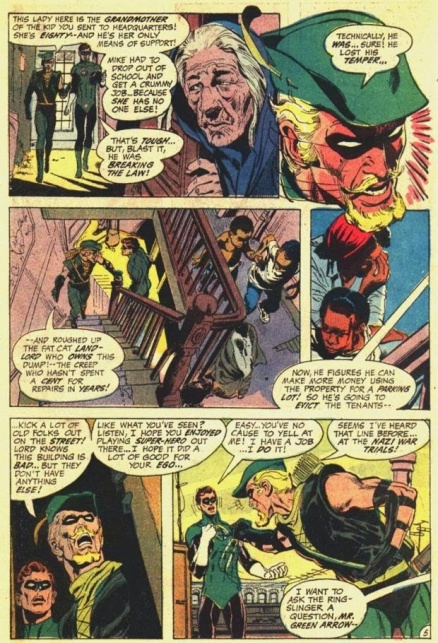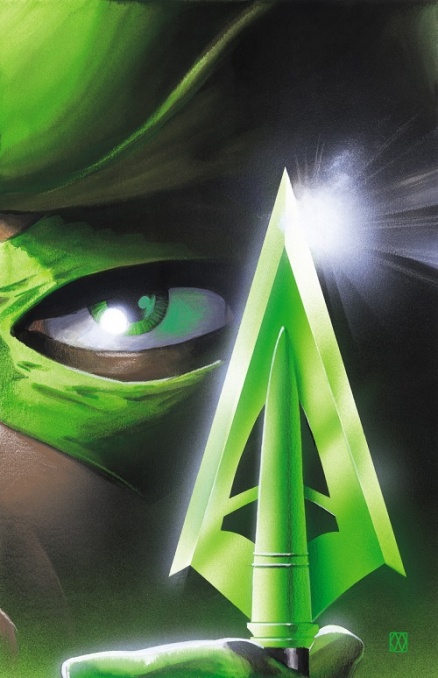
There are many interpretations of the World’s Greatest Archer but one can’t start without mentioning his origins.
When he was introduced in 1941, Green Arrow was originally quite different from his usual portrayal today. Created by Mortimer Weisinger and George Papp in “More Fun Comics” #73, Green Arrow actually started as an archaeologist who ended up becoming a superhero in order to save the treasure from a place called the Lost Mesa. Over the years, he developed a reputation as a deeply flawed man, a left wing dark vigilante, and even a Batman rip-off.

It’s easy to see how Green Arrow was originally considered a Batman rip-off. Everyone makes fun of the early days of Green Arrow due to the constant use of gadgets and devices that maybe would have been more familiar to the World’s Greatest Detective. There’s the Arrowmobile, the Arrowcave, the Arrowplane, and even an Arrowsignal. Speedy can easily be seen as inspired by Robin and things get even worse when you learn Green Arrow’s first archenemy was a criminal clown named Bulls-Eye.
Nonetheless, there are a few important differences between Green Arrow and Batman. Where Batman’s stories in the Golden Age tended to be more pulp-oriented, Green Arrow’s were a bit more diverse. Sure he was fighting common criminals, but he would also go into crazy adventures battling against different types of enemies and threats.
That’s one of the most relevant aspects of the Golden Age Green Arrow, not that he was a Batman rip-off but that he was at his heart an adventurer. The archeologist origin supports that idea. This helped him grow so popular he would also feature in the magazines “World’s Finest Comics” and “Adventure Comics.” He’d also become one of the few heroes that would be continued to be published after the Golden Age, surviving many of his contemporaries.
It’s a shame that the premise of the Golden Age Green Arrow was lost to benefit the better known versions from the Silver and Bronze Ages. There’s a huge potential in the original incarnation which could be implemented in the modern era with a bit of imagination. Hell, even someone like Bulls-Eye could work if writers showed some care.

Of course, one can’t mention Green Arrow without mentioning the well-known island origin. Created during the Silver Age by none other than Jack Kirby, who went to DC Comics after a royalties dispute with Marvel. Kirby tended to work on a few lesser-known characters. This incarnation sees Oliver Queen as a millionaire who gets stranded in an island where he’s forced to become an archer to survive. Obviously, this became quite influential for the character and received several interpretations and updates over the course of the years.
More important than that though, is that Kirby would make Green Arrow’s stories even more adventure-oriented. Several of the classic Kirby creative ideas injected into the character included the Green Arrows of the World, an organization consisting of archers of all nations (which clearly would draw more comparisons to Batman and his Batmen of all Nations, another creation of the Silver Age about a group of heroes from different countries inspired by Batman, a concept that Grant Morrison would reuse in the future).
Nonetheless, the revamps wouldn’t end there. Since in 1969 at the wake of the Bronze Age of comics, Dennis O’Neil and Neal Adams would reinvent the character. To start, they made him lose his fortune and suddenly care for the common man. Later he would co-star along with Green Lantern Hal Jordan in one of the most famous eras for the character. “Green Lantern/Green Arrow” was a title that explored real life issues, something quite progressive for its own era.
That being said, this era didn’t age well at all since many of the themes it explored were delivered in a pretty heavy-handed way by depicting both sides. Ollie was portrayed as a preachy and borderline insufferable guy who was completely unaware of how annoying he was while Hal was a clueless moron who needed to be constantly told about things that happened around him. It ultimately damaged both characters since future portrayals would try to distance themselves from this period by expanding on Oliver’s personality or, in Hal’s case, retconning this characterization by creating several explanations behind it.
Continued belowThis era particularly bothers me because the persona O’Neil and Adams invented for Green Arrow would become his only defining feature. They turned him into a caricature more than an actual person. O’Neill/Adams’s “Green Arrow” was pure theme, not an actual character which is one of the reasons why future writers would explore what actually happens in Oliver’s mind.
Once that the “Green Lantern/Green Arrow” series ended, Green Arrow would start his own solo career in a rather unremarkable miniseries by Mike W. Barr. It did, however, serve as a starting point for his next series. The event, “Crisis on Infinite Earths” brought a reboot to the entire DC universe in 1985 while books like “The Dark Knight Returns” cemented a grim and gritty trend in comics , This would start one of the most famous eras for the character.

Writer and artist, Mike Grell launched the miniseries “Green Arrow: The Longbow Hunters” in 1987 oriented for a more mature audience. It recreated Oliver Queen into a dark vigilante with stories that had a more realistic tone where barely any other character from the DCU, especially the more unrealistic ones, appeared. This is further cemented by making Oliver’s long-time girlfriend, Dinah Lance A.K.A. Black Canary, suffer a terrible attack where she lost her canary cry. Then the longest series for the character would begin with “Green Arrow” Volume 2. Once again handled by Grell with a similar style that was popularized in the previous miniseries it introduced several important characters for the franchise like Shado, member of a clan of assassins who would develop a romantic relationship with Oliver and Eddie Fyers, a mercenary who at first was at odds with Oliver but eventually becomes one of his allies and friends, and also served as a surrogate father for Oliver’s son. Grell’s run was also famous because it introduce concepts like violence and realistic issues.
Unfortunately, Grell’s overly dark and serious tone would become repetitive and tiring after a while with stories that constantly referenced similar ideas. However, if there’s something I can appreciate from his work on Green Arrow is not really the realistic direction but instead that he was the first person who would delve into Oliver Queen’s psyche and show the person he really is.
It was during Grell’s tenure that some of Ollie’s developed some more muddy traits. His overly emotional nature made him more likely to commit violent acts, even murder. He cheated on Dinah with a woman named Marianne. Though he eventually regretted these decisions, his actions would dictate much of his characterization for the following careers. This made him far more interesting. As mentioned before, his portrayal from the ’70s encompassed everything about Green Arrow, leaving little space for anything else. However, once Grell started developing a deeper character, things turned out more complex. It created the theory that maybe, just maybe, Oliver’s beliefs were a mask he used to hide some of his worst traits.
This would become even more evident once that “Green Arrow” Volume 3 began. After Oliver dies in an explosion, he’s replaced by his illegitimate son Connor Hawke, Connor himself was a quite interesting time for the title, you need to consider that he was created during the 90’s where violent badass/asshole superheroes were the norm, Connor however, was a pretty calmed young man thanks to his training as a monk and believed in reasoning before fighting. This creates an even bigger contrast with Oliver though, Oliver always let his emotions get the best of him, Connor on the other hand always controlled them which for the first time created a Green Arrow who was quiet, balanced and even borderline asexual.
Oliver was eventually resurrected in a story where he returned to Star City, except this time without a soul. Kevin Smith handled the premise and he probably did one of the most creative works in his career. Smith’s portrayal of Ollie is pretty much identical to O’Neill and Adams’s. At the same time, Smith stays so accurate to the era, it seems more as if he wants to ridicule it. After a few issues, it’s revealed that Oliver’s reborn body was only a shell and the actual soul of Oliver Queen was still in heaven.
Continued below
This creates a quite intriguing topic since it exemplifies perfectly how his character has been progressing since the Bronze Age, Oliver has been many things from liberal crusader to dark vigilante but Smith truly cemented what the real Oliver Queen would become at the end. Just when it appears that Connor Hawke is about to get killed trying to save his father from an horde of demons, Oliver’s body begs the true Oliver to return to life and save their son, but the latter initially refused it since he was at peace but also didn’t want to take responsibility for his kid. Smith was hinting that Oliver’s soul actually represents who he is at his core including all his flaws while his body, which was based on the liberal persona, represented his beliefs who only wanted him to do the right thing.
This kind of dilemma was even further explored by later writers. Brad Meltzer handled a little arc where he puts the revived Oliver into a quest to return his most precious possessions only to reveal a much darker truth. Oliver always knew Connor was his son but he rejected him when he was born and continued to reject him until his death. This is a common theme with Oliver since he would also do the same with his protege Roy Harper once that he learned he was a drug addict. Reject comes easily for him since he doesn’t want to handle the responsibility, only acting when it’s almost too late. Writer Judd Winnick also touched such points once that he made Oliver cheat on Dinah once again while lamenting the fact that he never thinks in the consequences of his actions.
That is pretty much the story of Oliver Queen, at least the most consistent before the New 52 reboot. since, aside from a great run by Jeff Lemire, the character wouldn’t be handled adequately due to multiple attempts at becoming more like the Arrow T.V. show or simply mishandling the social crusader aspects of the character.
These are the basics of the character though, he always lets his feelings speak for him and when they don’t, he lets his beliefs speak for him which unfortunately contradict most of his actions and ultimately make him look like a huge hypocrite but that is actually what makes him so unique. Few superheroes have the type of flaws that Oliver Queen has, flaws that are considered quite problematic by many but unsurprisingly makes him much more understandable and human. Any person can find at least little bit of themselves in him, the best characterization that Oliver receives is when he’s depicted as a man of many failings but never unlikable, if a writer makes him unlikable then they’re simply missing the point. He’s supposed to represent how a real man works and in a world full of superpowered beings, that’s one of the best things someone can ask for.






